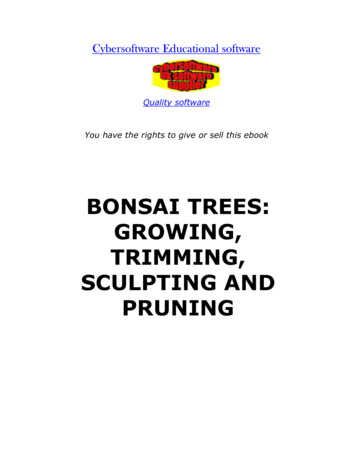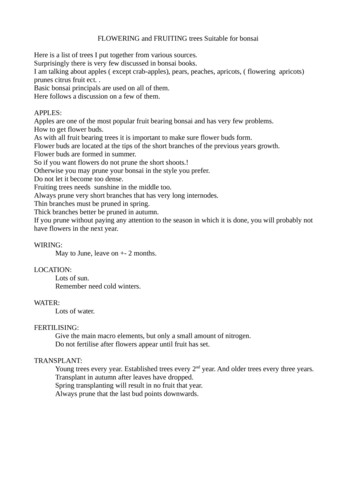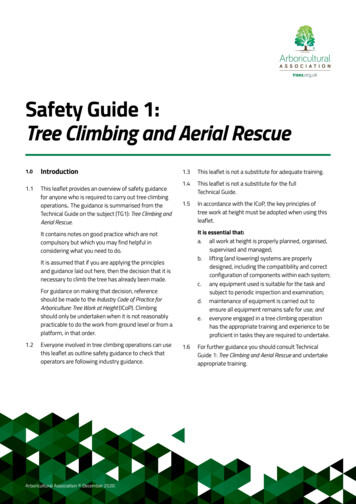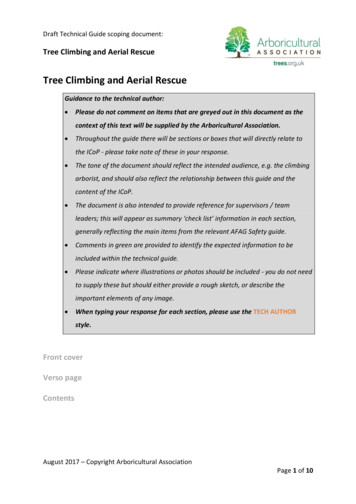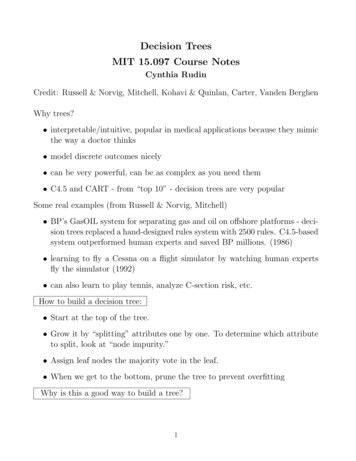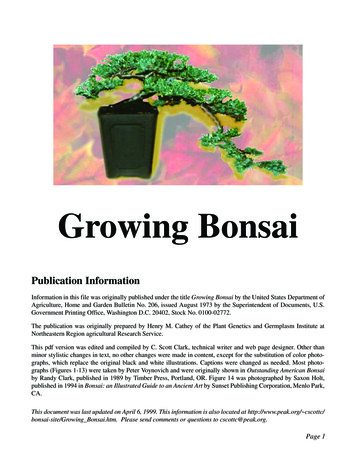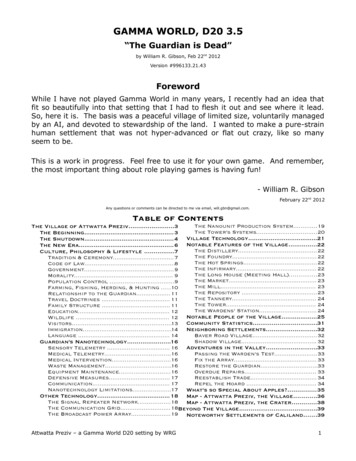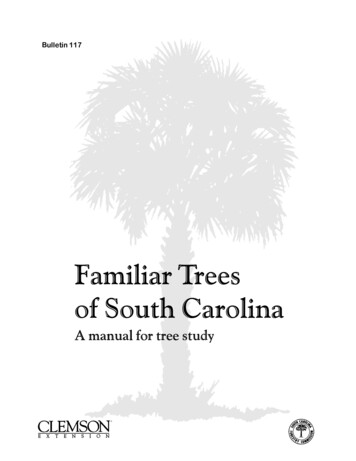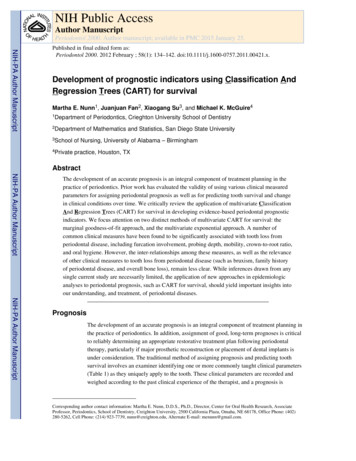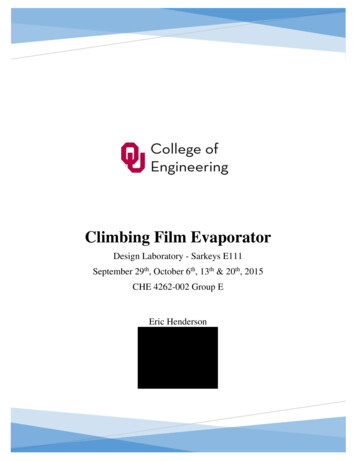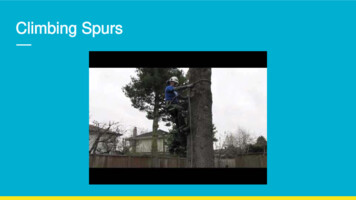
Transcription
Climbing Spurs
Throw ball
Body thrust
Footlocking
Single Rope Technique (SRT/SRS)
Work PositioningNo matter what technique you use, Remember that the climbing line is more than a safety deviceA good climber uses the rope to ascend into and descend from the treeAlso use it to access branch tips, maintain balance, and move freely in treeThe rope enables the climber to use both hands without any loss of stabilityUse both hands for working since your weight is on the climbing lineMaintain three points of contact with the tree (climbing line counts)
Tools in a Tree Pole pruner/saw, cablinghardware, other tools. Ground workers send up tools toclimber Clove hitch or slip knot iscommonly used Hang them so the sharp edge isaway from you Secure chainsaws with a chainsawlanyard for use in a tree Keep two hands on the saw whencutting and shut off the chainsawand engage chain brake whenmoving to another position
EmergencyResponse andAerial Rescue
EmergencyResponse andAerial Rescue3.2.4 Employees who may befaced with a rescue decision shallreceive training in emergencyresponse and rescue proceduresappropriate and applicable to thework to be performed, as well astraining to recognize the hazardsinherent in rescue efforts.
Key Points Aerial rescue is the process of safely bringing an injured or unconscious worker inlife-threatening situation to the ground. There must be a minimum of two climbers on the site capable of aerial rescue Electrocution, heart attack, heat exhaustion, insect/animal attack, blow fromswinging limb or chain saw could leave a worker dangling helplessly in a tree.Aerial Rescue Flowchart.pdf
What to do. Assess the situation and have someone call for emergency help immediatelyGive the exact location of the accident and nature of emergencyBe sure to tell operator if it involves a high-angle rescue or electrical hazardsNever risk becoming a second victim or putting others in danger
CPR/First AidTraining3.2.5 For field crews involvingtwo or more workers at a worklocation, at least two workerstrained in first aid/CPR shall beavailable.
Rigging Equipment
Fundamental Rigging Techniques
Types of CutsDrop cut, snap cut, hinge cut
Drop Cut Classic 3-point cut dating back to the early years of arboriculture. Recommended technique for removing large limbs: The first cut is an undercut approximately ⅛-¼ deep.The second cut is made directly on top of the firstThe third cut removes the stubNote:This was originally taught by making the second cut (top cut) further out on thebranch. This can create a kerf and pull the chain saw out of the climber’s hand.
Drop CutCont.
Snap Cut (Mismatch Cut)Cont.
Hinge Cut A variation of standard tree-felling techniques that employs the use of a notchand back cut to form a hinge and “steer” the limb. Recommended technique for swinging a limb around rather than simplydropping the branch to the ground: The first cut is a felling top cut to begin the notch.The second cut is the bottom or undercut to finish the notchThe third cut is a stepped up back cut following standard felling techniquesNote:Unless the limb is properly rigged with a load line, there is a limit to how much theclimber will be able to swing it before it drops. If the hinge is formed too far up the sidethe limb, it may be ineffective, and the hinge may break before the limb swings.
HingeCutCont.
Resources to considerOrganizations: Tree Care Industry Association International Society of Arboriculture ISA TexasLiterature: Basic Training for Tree Climbers DVD and workbookTree Climbers’ Guide, 3rd EditionThe Tree Climber’s CompanionArborist EquipmentSafe Work Practices, A Collection of CEU Articles
More ResourcesSuppliers SHERRILLtree TreeStuff WesSpur Tree EquipmentKnowledge ClimbingArborist.com TreeBuzz.com ArboristSite.com
Sample Test Questions1) A “rope inside a rope” is better known as a:a) Hollow-braid lineb) 12-strand linec) Double-braid lined) 3-strand line2) A Prusik loop is used:a) To tie in with the secured footlock methodb) To attach a tagline to a limbc) As an arborist block for lowering limbsd) To cable, small, multi-stemmed trees3) A separate, short length rope used to tie the friction hitch inan open climbing system is known as:a) Prusik loopb) Split-tailc) Work-positioning lanyardd) Rope sling4) The first steps of the emergency responseprocess are to:a) Assess the situation and call for emergencyhelpb) Shut off the electricityc) Reach the victim and begin first aidd) Reach the victim and secure him or her fordescent5) The classic three-step cut used to removelimbs is also called the:a) Drop cutb) Jump cutc) Hinge cutd) Topping Cut
Tree Climbers’ Guide, 3rd Edition The Tree Climber’s Companion Arborist Equipment Safe Work Practices, A Collection of CEU Articles. More Resources Suppliers SHERRILLtree TreeStuff WesSpur Tree Equipment Knowledge ClimbingArborist.com TreeBuzz.com ArboristSite.com . Sample Test Questions. 1) A “rope inside a rope” is better known as a: a) Hollow-braid line b) 12-strand line c)
